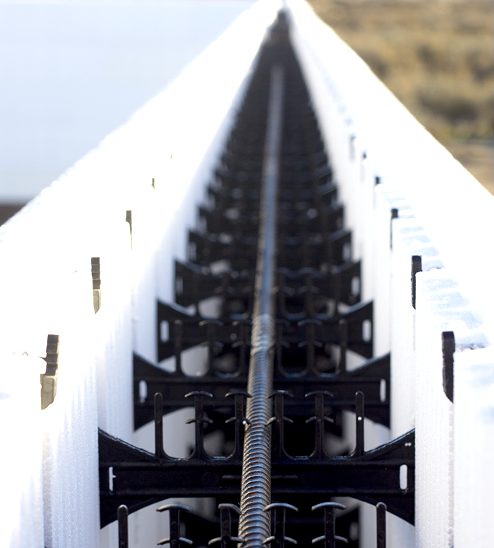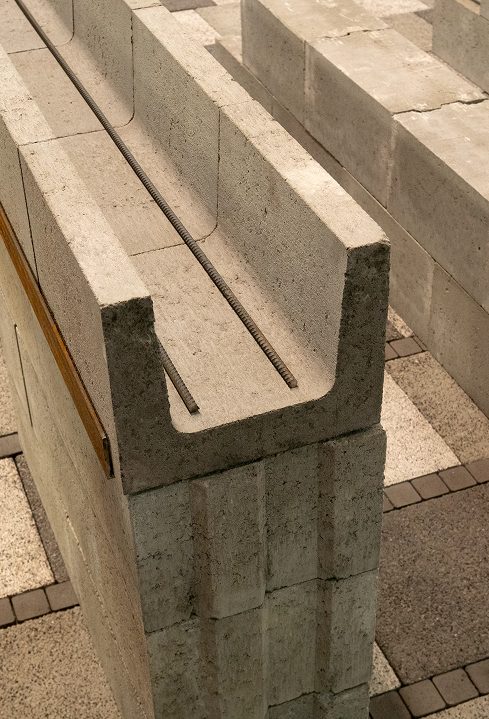ICF construction is a modern technique that merges the strength of concrete with the energy efficiency of insulation using interlocking forms filled with concrete.
Insulated Concrete Form (ICF) construction is a modern building method that combines concrete’s strength and durability with excellent energy efficiency. It uses interlocking hollow forms made of expanded polystyrene (EPS) or other insulating materials, which are stacked and filled with concrete to form the structure’s walls.
HOW IT
WORKS
The ICF construction
process generally includes
the following steps:
Formwork Assembly
The interlocking ICF forms are assembled on-site to create the desired wall shape and size. These forms consist of two panels connected with plastic or metal webs, creating a cavity between them.
Reinforcement Placement
The interlocking ICF forms are assembled on-site to create the desired wall shape and size. These forms consist of two panels connected with plastic or metal webs, creating a cavity between them.
Concrete Pouring
The interlocking ICF forms are assembled on-site to create the desired wall shape and size. These forms consist of two panels connected with plastic or metal webs, creating a cavity between them.
Curing and Finishing
The interlocking ICF forms are assembled on-site to create the desired wall shape and size. These forms consist of two panels connected with plastic or metal webs, creating a cavity between them.
COST
Due to lower relative operating expenses, ICF property ownership costs are consistently lower over time compared to traditional construction. ICF structures also require significantly less maintenance throughout their extended lifespan.
To enhance energy efficiency, owners often install energy-efficient water heaters, windows, and other features, further reducing energy expenses. Additionally, a 1 Euro reduction in operating costs for ICF homes can increase the value of a typical home by 20 Euros. Therefore, if you save an average of 250 Euros a month on energy, your home could be worth about 50,000 Euros more than comparable traditionally built homes.
How Long Does Construction
Take?
The completion time depends on various factors, such as the building’s size and complexity. For instance, Rapidform typically expects to complete a standard two-story semi-detached block of houses in 10 working days from floor to wall plate.
Why use ICF
Construction
Construction Speed
ICF building technology is lightweight and user-friendly, requiring less labor than traditional methods. This efficiency saves significant time, as ICF structures can be assembled quickly and are less affected by adverse weather conditions compared to block or timber construction.
Savings on Energy Bills
ICF building technology is lightweight and user-friendly, requiring less labor than traditional methods. This efficiency saves significant time, as ICF structures can be assembled quickly and are less affected by adverse weather conditions compared to block or timber construction.
Fire Resistance
ICF building technology is lightweight and user-friendly, requiring less labor than traditional methods. This efficiency saves significant time, as ICF structures can be assembled quickly and are less affected by adverse weather conditions compared to block or timber construction.
Wind Resitance
ICF building technology is lightweight and user-friendly, requiring less labor than traditional methods. This efficiency saves significant time, as ICF structures can be assembled quickly and are less affected by adverse weather conditions compared to block or timber construction.
Airtightness
One of the key benefits of the ICF construction system is its exceptional airtightness. The continuous insulation in an ICF structure prevents outside air from infiltrating the building, thereby improving its BER rating.
Construction Safety
One of the key benefits of the ICF construction system is its exceptional airtightness. The continuous insulation in an ICF structure prevents outside air from infiltrating the building, thereby improving its BER rating.
Durability
One of the key benefits of the ICF construction system is its exceptional airtightness. The continuous insulation in an ICF structure prevents outside air from infiltrating the building, thereby improving its BER rating.
Insulation & Energy Efficiency
ICF buildings excel in energy efficiency due to minimal air exchange with the outside, eliminating drafts common in traditional construction and enhancing comfort. Heating and cooling costs are notably lower in ICF buildings compared to traditional methods, offering substantial financial savings.
With their airtightness and effective insulation, ICF buildings typically halve energy expenditures compared to conventional construction. Additional savings can be achieved through proper attic insulation, air-sealing, and the use of energy-efficient windows and doors.

Maintenance
Maintenance is often seen as a necessity or unavoidable expense in traditional homes, especially those built with timber frames. In contrast, ICF homes require minimal maintenance. Thanks to the structural integrity of ICF buildings, future issues are mitigated, allowing the home to maintain its original condition over time.
The combined benefits of ICF result in reduced maintenance costs. Airtightness prevents condensation and mold while safeguarding against structural and aesthetic wall damage. The concrete framework further ensures the building’s long-term durability and structural integrity.

Exterior & Interior Design Finishes
ICF can be finished with render, brick, stone, timber cladding, or any desired material. Prefinished concrete panels offer a modern minimalist look. Many choose acrylic render, available in various colors, eliminating the need for painting and ensuring long-lasting color retention, saving costs over time.
You have full flexibility in choosing interior finishes. The rigid ties that separate the sheets include anchor strips on both sides of the foam sheets. These strips are designed for screws that secure materials like drywall and furring strips, accommodating a wide range of finish options.
For the interior, you have complete freedom to choose your finishes. The rigid ties separating the sheets include anchor strips on both sides of the foam sheets, designed for attaching materials such as drywall and furring strips that can support various finish materials.
